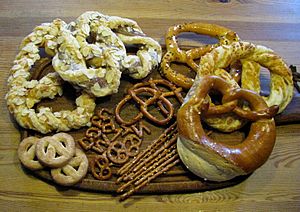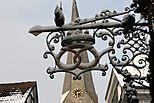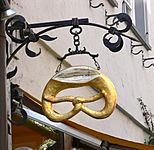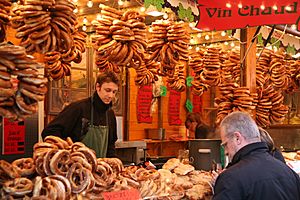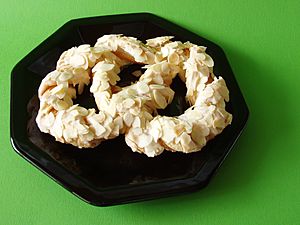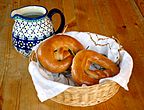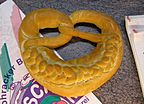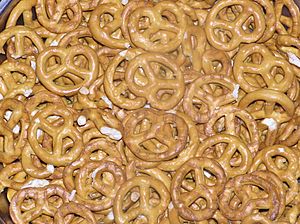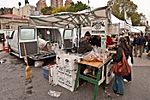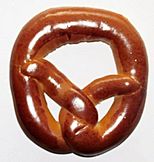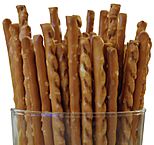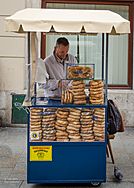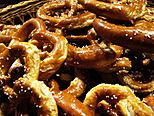Pretzel facts for kids
|
An assortment of pretzels
|
|
| Type | Bread or Pastry |
|---|---|
| Course | Snack |
| Place of origin | Germany |
A pretzel (called Breze or Brezel in German) is a type of baked bread. It is usually shaped into a special twisted knot. The traditional pretzel shape is symmetrical, with the ends of a long strip of dough twisted back into itself. Today, pretzels come in many different shapes.
The most common topping for pretzels is salt. This salt goes well with the special treatment pretzels get, which uses washing soda or lye. This treatment gives pretzels their unique skin and flavor. Other toppings can include different cheeses, sugars, chocolate, glazes, seeds, or nuts. There are two main types of pretzels: soft pretzels, which you eat soon after they are made, and hard-baked pretzels, which last a long time.
Many popular stories say that a Christian monk invented the pretzel to look like arms crossed in prayer. However, pretzels actually existed in Europe centuries before Christianity.
Contents
The Story of Pretzels

There are many interesting stories about where pretzels came from and how they got their name. Most of these stories suggest they have a Christian background and were invented by monks in Europe. One legend says a monk in 610 AD created them. Another story says they were invented in a monastery in southern France. In Germany, some tales say pretzels were made by bakers who were held captive!
Even though these stories are popular, the true origin of the pretzel might be much older than Christianity. Some experts believe pretzels came from ancient traditions, possibly as a symbol. The German name "Brezel" might come from the Latin words bracellus (meaning "bracelet") or bracchiola (meaning "little arms").
Pretzels have been a symbol for bakers and their guilds (groups of skilled workers) in southern Germany since at least the 12th century. An old drawing from the 12th century in a book called Hortus deliciarum shows what might be the earliest picture of a pretzel.
In the Christian Church, pretzels were seen as important for their ingredients and shape. Pretzels made only with flour and water could be eaten during Lent. This was a time when Christians were not allowed to eat eggs, lard, or dairy products like milk and butter. Over time, pretzels became linked to both Lent and Easter. Sometimes, pretzels were hidden on Easter morning, just like eggs are hidden today. They are especially connected to fasting and prayers before Easter.
The loops in pretzels might have also had a practical use. Just like holes in Swedish flatbreads allowed them to be hung on strings, bakers could hang pretzels on sticks. A painting from around 1681 by Job Berckheyde shows this.
Bakers' Special Symbol
-
The pretzel is a symbol for bakers, here with two lions, in Görlitz, Germany.
-
A bakery symbol in Hattingen.
-
A bakery symbol with a cut in the pretzel, Ravensburg.
Pretzels Around the World
Pretzels in German-Speaking Areas

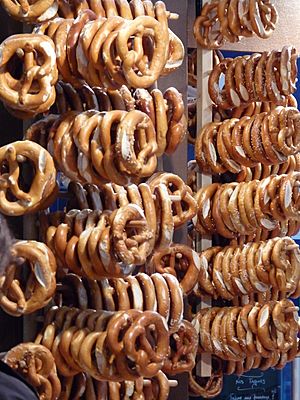
Pretzels are very popular in southern Germany, Alsace, Austria, and German-speaking Switzerland. They have been a big part of German baking for hundreds of years. Lye pretzels are a common type of bread, side dish, or snack. Almost every region and city has its own way of baking them.
You can find pretzels with different names in various German dialects, like Breze, Brezn, or Bretzel. They are baked fresh every day and sold in bakeries and special stands. Often, they are sliced open, buttered, and sold as Butterbrezel. You can also find them with cold meats or cheese. Other popular toppings include sesame, poppy, sunflower, or caraway seeds, melted cheese, and bacon bits. Some bakeries even make pretzels from different flours, like whole wheat or rye.
In Bavaria, lye pretzels are often eaten with a main dish, like Weisswurst sausage. The same dough and baking process are used to make other "lye pastry" items like rolls, buns, and croissants. Bavarian pretzels have thicker arms so they don't get too crispy.
The pretzel shape is also used for many sweet pastries made from different kinds of dough. These can have toppings like icing, nuts, or cinnamon. Around Christmas, you might find soft gingerbread pretzels with chocolate.
In southern Germany, pretzels still have their old religious meanings and are used in many traditions. On January 1st, people sometimes give each other slightly sweet yeast pretzels for good luck. These "New Year's pretzels" can be very large, sometimes more than 50 cm (20 inches) wide! Children might visit their godparents to get their New Year's pretzel. On May 1st, boys used to paint a pretzel on the doors of girls they liked.
In Catholic areas like Austria and Bavaria, "Palm pretzels" are made for Palm Sunday celebrations. These can be very big, weighing up to 2.5 kg (5.5 pounds)! An old tradition from 1533 is the outdoor pretzel market near Heldenfingen.
In the Rhineland region, sweet pretzels are made with pudding inside the loops. On Laetare Sunday in Luxembourg, which is the fourth Sunday in Lent, there is a "Pretzel Sunday" festival. Boys give pretzels or pretzel-shaped cakes to their girlfriends. The size of the pretzel shows how much he likes her! If a girl wants to show she likes him back, she gives him a decorated egg on Easter.
The town of Weidenberg celebrates "Pretzel weeks" during carnival season. During this time, anise-flavored pretzels are served with special dishes.
In Lübeck, a 500-year-old group of boatmen holds an annual meeting called Kringelhöge (Pretzelfun). This big event includes a breakfast with beer and songs by a children's choir. In the past, poor children from an orphanage would get a pretzel as a reward, which was a big treat. Today, children from schools still get pretzels.
The city of Osnabrück celebrates the anniversary of the Peace of Westphalia (1648) with an annual hobby horse race for fourth-grade children. After the race, they get a sweet pretzel.
The lye pretzel is also the theme for several festivals in Germany. The city of Speyer calls itself the "pretzel town." Around the second weekend of July, it holds an annual festival called "Brezelfest." This is the largest beer festival in the Upper Rhine region, attracting about 300,000 visitors. The festival includes a parade with over 100 bands and floats, and 22,000 pretzels are thrown to the crowds! In Speyer's market square, there's a fountain with a statue of a boy selling pretzels.
-
A New Year's pretzel from a bakery in Stuttgart (Swabia).
Pretzels in the United States
In the late 1700s, immigrants from southern Germany and Switzerland brought pretzels to North America. These immigrants became known as the Pennsylvania Dutch. Over time, many handmade pretzel bakeries opened in central Pennsylvania, and pretzels became very popular.
In the 1900s, soft pretzels became popular in other parts of the United States. Cities like Philadelphia, Chicago, and New York became famous for their soft pretzels. This happened because new mass production methods made pretzels more available. They were sold in schools, stores, and at places like movie theaters and sports stadiums. Before this, street vendors sold pretzels from glass cases on street corners.
Pennsylvania's Pretzel Love
The S-shaped soft pretzel, often eaten with brown mustard, became very popular in Philadelphia. It became a common snack or quick meal. The average person in Philadelphia eats about twelve times more pretzels than the national average! Pennsylvania is the main place for making both hard and soft pretzels in America. Southeastern Pennsylvania, with its large German population, is seen as the start of the American pretzel industry. Many pretzel bakers are still there. Pennsylvania makes 80% of all pretzels in the United States.
The American pretzel industry is worth over $1.2 billion each year. The average American eats about 1.5 pounds (0.7 kg) of pretzels per year. A private "Pretzel Museum" opened in Philadelphia in 1993. In 2003, Pennsylvania Governor Ed Rendell declared April 26th "National Pretzel Day." On this day, Philly Pretzel Factory stores give a free pretzel to every customer.
Hard pretzels started in the United States. In 1850, the Sturgis Pretzel House in Lititz, Pennsylvania, became the first business to make hard pretzels. These hard pretzels are made in shapes like loops, braids, letters, or sticks. They are about 3 mm (1/8 inch) thick and 12 cm (5 inches) long. They have become a popular snack worldwide. Thicker sticks, about 1.5 cm (1/2 inch) thick, are called Bavarian pretzels or pretzel rods in the U.S. Unlike soft pretzels, these last a long time when kept in an airtight container. Large-scale production began in the early to mid-1900s. In 1949, a company invented a "pretzel bender" machine that could twist and tie 50 pretzels a minute!
In Europe, snack pretzels usually have salt. But in the U.S., they come in many flavors and coatings, like yogurt, chocolate, strawberry, or cheese. Chocolate-covered hard pretzels are popular gifts around Christmas. The many shapes and sizes of pretzels became a fun way to market their taste. In the 1900s, people in Philadelphia would eat small pretzel sticks with ice cream or crumble them as a topping. This mix of cold, sweet, and salty was very popular. This even led to ice cream cones that tasted like pretzels! More recently, Mars, Incorporated makes M&M's with a small pretzel inside, covered in milk chocolate and candy coating. Soft pretzels are often sold in shopping malls by chains like Auntie Anne's.
- Important Moments in Pennsylvania Pretzel History
Other Pretzel Cities
Freeport, Illinois, about 100 miles from Chicago, is also known for its pretzel history. In 1869, a German immigrant named John Billerbeck started the first Billerbeck Bakery. It was famous for selling German-style pretzels, which went well with the many breweries in Freeport at the time. When Prohibition stopped the breweries, pretzel sales went down. But Freeport never lost its pretzel pride. For over 100 years, Freeport has been called "Pretzel City, USA." Their high school sports team mascot is the Pretzel, and their football stadium is called "Pretzel Field." In 2003, citizens started Freeport's first Pretzel Festival. It's a big community event where people celebrate the city's pretzel history. There's even a festival mascot named "Pretzel Bill," a 6-foot-tall walking pretzel who gives out pretzels and takes photos!
Pretzels in Other Countries
While not as popular as in German-speaking countries and the U.S., the looped pretzel is known in other European countries and around the world. In the Czech Republic, it's called preclík. In Finland, it's viipurinrinkeli. In Slovakia, it's praclík. The Spanish and French call it bretzel, and the Italian brezel. The Dutch have sweet versions called krakeling. Norwegians and Danes call it a kringle, and the Swedish call it kringla. In Polish, it's precel, in Hungarian and Croatian it's perec, and in Serbian it's pereca. In Romania, the pretzel is a type of covrigi and is a very popular fast food and holiday gift.
-
A street vendor in Kraków, Poland, selling pretzels (called precle in Polish), as well as obwarzanki krakowskie and bagels.
-
Bretzels in Strasbourg.
-
Brașov pretzels with poppy seeds and salt.
Images for kids
-
A miniature salted pretzel, shaped like a Christmas tree. Sold in England by Aldi in 2019.
-
Clara Peeters, Still Life with Cheeses, Almonds and Pretzels, 1685.
-
Jan Steen, Baker Arent Oostwaard and his wife Catherina Keizerswaar (1658) features pretzels, Rijksmuseum.
-
A bakery symbol used as a logo at a Danish bakery in Ballard, Seattle.
-
Swedish home-baked sweet pretzels known as kringlor, some with chocolate.
See also
 In Spanish: Bretzel para niños
In Spanish: Bretzel para niños


